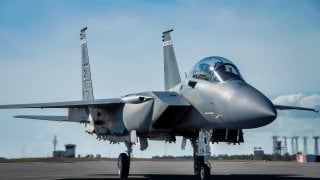The F-15EX Eagle II Proves You Don't 'Need' To Be a Stealth Fighter
The U.S. Air Force's F-15EX Eagle II is set to replace the aging F-15C/D fleet, initially tasked with homeland defense, but its role may expand dramatically. Boeing and the Air Force are exploring new uses for the Eagle II, including serving as a drone coordinator for unmanned systems, an electronic warfare platform, and a high-capacity missile truck.
But the F-15EX’s ability to carry oversized loads could prove highly useful in the air superiority mission as well. In recent months, we’ve gotten a good look at the U.S. Navy’s new AIM-174B – an air-launched variant of the ship-launched SM-6 interceptor that has the potential to engage airborne targets at ranges possibly in excess of 300 miles. This weapon was designed specifically with the Naval Integrated Fire Control-Counter Air (NIFC-CA) architecture in mind, which is effectively a network of battlefield assets that will allow Super Hornets to get target information from forward advancing stealth fighters or powerful ship-based radar arrays and engage them with the AIM-174 even when the Super Hornet itself cannot see the target on its own radar scope.
The F-15EX, with its superior payload capacity, could excel in a similar role for the U.S. Air Force, and in fact, there’s been mention of the aircraft doing precisely that dating all the way back to budget documents in 2022 that referenced Eagle IIs carrying an as-yet-undisclosed very-long-range air-to-air missile. That weapon could potentially be based on the Navy’s AIM-174, which was certainly in development and testing well before being formally acknowledged by the Navy earlier this year, or it could potentially be one of several other missile programs in development under names like the Long Range Engagement Weapon (LREW).
Making the Eagle II into a tactical refueling tanker
The United States maintains the world’s largest fleets of aerial refueling platforms, enabling air operations all around the globe, but tanker aircraft are extremely vulnerable assets in a high-end fight. As such, the U.S. Air Force and Navy alike have been pursuing a number of ways to distribute tanker duties across a wider variety of more survivable platforms in recent years.
And it was seemingly with this concern in mind that the innovation-focused arm of the Air Force Research Lab (AFWERX) awarded two developmental contracts in late August to develop and field “buddy” tanker pods for the F-15 family of aircraft that could allow platforms like the Eagle II to serve as high-performance refuelers closer to contested airspace than a tanker might venture to fly.
This is not a new concept, of course, as the U.S. Navy has used tactical aircraft for refueling duties for years, and more recently, began testing its new MQ-25 Stingray refueling drone that operates in a similar capacity. These F-15 tanker pods, however, would employ the Air Force’s preferred boom method of fuel transfer, rather than the Navy and Marine Corps’ probe-and-drogue method.
And this is, once again, a place where the Eagle II’s speed, payload capacity, and survivability could make it a boon for American airpower even without trading blows in contested airspace. F-15EXs equipped with buddy tanker pods could even serve as something of a bridge between vulnerable tanker aircraft operating further away from the fight and stealth fighters like the F-35 and F-22 conducting combat operations in contested airspace. When the stealth fighters need a top-up, they could meet Eagle IIs for rapid refueling before heading back into the fight, while the F-15EX then turns and heads away from the fray to meet up with a tanker and refill its stores for the next stealth fighter in need of a pit stop.
Contracts were awarded to Legionnaire International and Leidos subsidiary Dynetics to develop this concept, under the name Small Hybrid Aerial Refueling Kit (SHARK), but it’s likely to be some time before we learn more about when the capability might find its way to service.
About the Author: Alex Hollings
Alex Hollings is the editor of the Sandboxx blog and a former U.S. Marine that writes about defense policy and technology. He lives with his wife and daughter in Georgia.


